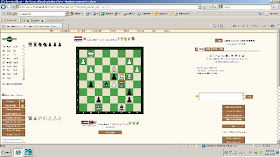I ran across this ad today. I can't believe anybody would actually purchase cheats for these sites!
Chess-Auto Buddy does more than play Yahoo chess™ and Pogo chess™... this chess auto puts you in league with the pros! If you're one of the many chess players who is intimidated by chess, has a low rating, or just wants to learn how to play, then there is a perfect chess bot for you -- Chess-Auto Buddy! Created specifically with you in mind, this chess cheat completes any job; need a Yahoo chess ratings boost, pile of Pogo tokens, or a Pogo chess badge? No problem. With Chess-Auto Buddy, consider it done. Whether you want to use the advanced chess strategy to earn a 2200+ rating in the span of a day, or want something to offer you hints when you need them, this is the chess auto for you. Chess-Auto Buddy is a chess cheat no Pogo chess or Yahoo chess player should be without. Download your free 7-day trial today!
COMPLETELY AND 100% UNDETECTABLE!! Others can only guess if a Pogo cheat or Yahoo cheat is being used, so play with confidence!
Plays Yahoo Chess and Pogo Chess automatically.
Pogo players: Works in Club Pogo and free account Chess rooms.
So powerful, it plays 1-minute games and can hold its own against 2000+ rated players!
Allows users to swap out the default .uci engine with one of their choice.
Includes play hint and show hint features to use during manual play.
Earn thousands of Pogo tokens or Yahoo points while you work or sleep - get Pogo badges and a Yahoo chess ratings boost faster than ever before!
Precise and reliable. This chess auto will not let you down in the middle of an important game or tournament.
Contains quick and easy built-in backdoors to favorite Chess rooms.
Programmed with multiple features and customizable options making this the best Pogo cheat and Yahoo cheat available for Chess.
Free unlimited Chess-Auto Buddy upgrades for a year after purchase
Friendly online technical support.
And *much* MORE - try it today for free!












